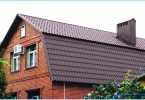The contents
One of the most important things when building a house is selecting the type of your future roof. Thus, it is not only the shape of the roof and the degree of the slope, but the type of roofing material. Modern trends in construction involve the creation of complex roofs of buildings that has a lot of elements with complex geometry – cones, domes etc.
Naturally, such a roof is able to transform even ordinary-looking building, but only if it is selected «right» roofing material, which not only decorate the structure but also will become a reliable protection from any external influences. From the variety of materials used for roofing, the most versatile and practical can be considered a shingles that has a lot of qualitative differences from other types of coverage.
Asphalt shingles is a three-layer material, as the basis of which is rubber-bitumen layer. Its main objective is to provide reliable waterproofing of the roof. For the middle layer is solid fiberglass, which in addition to strength, this material provides high elasticity, which gives the opportunity to use the shingles on complex roofs. For the top layer used stone granules (marble, granite, basalt) a small fraction with different colors.

Shingles – pros and cons of the material ↑
In order to be able to answer the rather difficult question which is better – metal or shingles, you should be familiar with the advantages of the latter:
- high degree of resistance of shingles to the formation of fungus and the impossibility of its decay;
- no corrosion;
- wide temperature range that allows its use (-60… +1300C);
- excellent material characteristics in terms of insulation – even a heavy downpour will not cause acoustic discomfort;
- no need for the installation of devices for the snow guard;
- light weight material allows you to do lightweight truss construction;
- not being electrically conductive material, the installation of the lightning protection system is not required;
- the possibility of laying shingles on the roofs of complex geometry;
- comparative ease of installation and high maintainability of the roof;
- excellent aesthetic characteristics.

All commercially available shingles is divided into 2 classes. Class «And» suggests that the basis of durable fiberglass, and the service life of such coverage will be 25-30 years. shingles class «With» made with a base of cardboard, has a lower cost and a service life of 10-15 years.
Features of work with shingles ↑
In order to evaluate the benefits of roof shingles, you should follow some of it.
- Until the immediate lifting of the shingles on the roof, keep it should be in original packaging in a closed room, putting them more than 16 rows in height. If the works you plan to use carpet underlay, roll with it stored in a vertical position.
- To purchase the required number of shingles immediately, better with a small margin, making sure that the packaging belonged to one party – thus will avoid differences in the shade of the shingles.
- Plan the installation of shingles should be at zero ambient temperatures, pre-after enduring all the material (tiles and carpet underlay) in a heated room during the day.
- It should be understood that shingles Shinglas cannot be processed by the burner, because it is not classified as a filler of the roof. Therefore, when installing shingles in the cold season it is necessary to use a special mastic or bitumen adhesive.
- Each shingle has a protective coating, adhesive layer, to remove which it is only necessary before laying.
- Walking on the finished roofing shingles is impossible, so it is important to think about the installation of special cats or ladders.
Substrate preparation ↑
Installation of the shingles with his own hands performed the easier than the more carefully prepared base. It is important to pay sufficient attention to the quality of the base because shingles KATEPAL, like any other, requires qualitative and continuous base. You can use polished boards, moisture resistant plywood, but the best option would be OSB-plate, high strength, insensitivity to moisture and resistance to temperature extremes.

The next stage of the training grounds is the installation of the underlay. When the value of the slope of the roof is less than 300, the carpet is laid on the entire slope, if the roof is steeper, the permissible use it only under the ridge and in the joints of the Windows, walls or chimney. With the continuous laying of the carpet is necessary to provide overlap not less than 0.3 mm to prevent the formation of ice on the ledges and the edges of the roof are mounted drip.
Technology of installation of roofing shingles ↑

All shingles, for reviews, simple installation and the main thing – accuracy. Excessive haste can lead to uneven stacking or defective fastening of the shingles. At the initial stage it is necessary to conduct a horizontal layout. For this it is convenient to use ordinary chalk, drafting marking line for every 5 rows of tiles.
The vertical markings, if it is needed, start from Windows, pipes and other items that need to be circumvented. About the process of laying shingles is told in the video
The technology of laying of the shingles involves fastening each element of the roof membrane by means of special nails. Recommended length is at least 2.6 mm, and the width of the cap is not less than 0.08 cm.

Out galvanized nails that will not corrode. On each tile you will need to use 4 nails. Special attention should be paid to the depth of the plugging – in low, nails will stand out on the surface, if excessive, easy to damage the roofing material. In addition, in the formed depressions to accumulate water, which is undesirable.
Some features of installation of the shingles ↑
To roof shingles looked perfectly neat and aesthetically pleasing, the process of laying shingles starts from the middle line, moving right and left. Installation is carried out bottom-up, so the work “starts” from the eaves. Pre-backing on the carpet you must fix yourself cornice trims, made of metal. For fastening use nails or screws with a big hat, arranging them in a zigzag pattern at a distance of 10 cm from each other. The overlap at fastening straps must be at least 5 mm.

The first line is laid out special, eaves with shingles, but if the selected manufacturer, they are missing, you can crop and standard. Here you should follow the particular manufacturer of the shingles – someone recommends to do a small overhang of shingles, someone on the contrary, to leave a small gap. After that, start laying the first row of shingles, fixing each of them with 4 nails. If the roof is installed in areas with strong winds, be sure to use the glue or asphalt mastic.
The layout of the complex elements of the roof ↑

Unlike most other roofing materials, laying shingles possible on the most challenging rooftops, for which there are a variety of turrets, Bay Windows, dormers complicated designs. Due to its plasticity, shingles can reliably protect these structures against the penetration of moisture inside the house, and to preserve the unity of style for the whole roof. When making such tiles attic, shingles located on the roof, be sure to start on the side walls of width not less than 15cm in laying shingles on the side walls of the attic is in the horizontal direction.
Semi-circular Dormer Windows do not differ complexity to the design, and the main point is the correct markup of the roof. Visually, the line of the cornice should be interpreted as zero, and rows of shingles have no breaks to go to the Bay window (the window). The most time-consuming processes should include the laying of iko shingles on the round towers, which are often crowned by modern cottages. It is worth considering that work on the towers being down, and not Vice versa as in the rest of the roof. All the shingles are laid on the base of the tower should be recorded with glue and nails.

Regardless of what kind of shingles were used TECHNONICOL domestic production, or more expensive specimens from Europe, all the work should be carried out with a high degree of precision and accuracy. Should not be forced heating, new roof, since shingles are designed so that the maximum protective characteristics will show up after it is warmed naturally by the rays of the sun. Additional heating of this material is permitted only when performing work at low ambient temperatures, or when making complex design elements.







